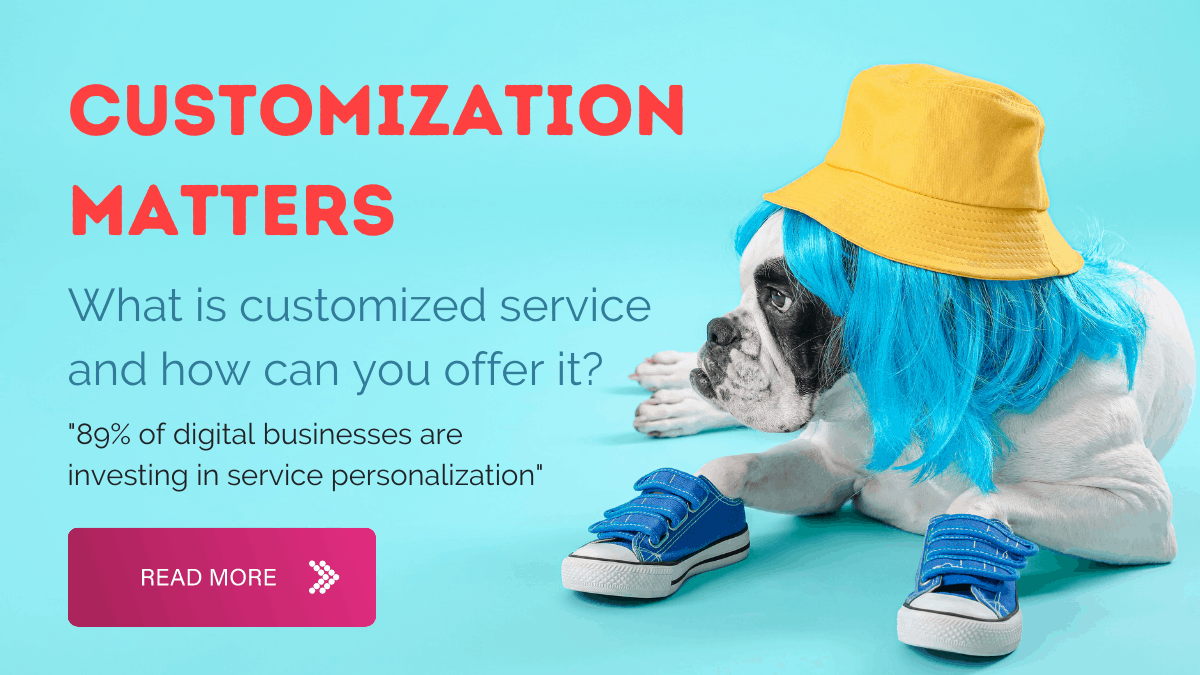No two buyers are identical.
And not all customers want the same thing from your product.
That can make life…
But you can help yourself out by letting people customize your service based on their needs.
It’s a surprisingly easy way to help users get what they want from interactions with your business.
(Want more articles like this in your inbox? Click here to get our fortnightly CX newsletter.)
What is customized service?
Customized service is any service that’s tailored to the needs of individual customers.
The math is simple – if the service better fits their needs, you’ll be more successful in service, sales and retention.
The phrase “customized service” is used in two ways.
Sometimes it’s used interchangeably with personalized service.
When that’s the case, we’re talking about altering your service based on what *you* know about that customer’s needs.
Here are three examples of that in the contact center:
- When a customer calls your contact center, your routing system recognizes their location and sends them to a relevant agent.
- A customer calls, and your IVR system notices they have an outstanding order. The system provides them with order status updates.
- You notice that customers who buy a particular service often contact you with a specific question. You proactively send this segment of customers a message explaining the issue.
In each of these examples, you’re using something you know about the customer to provide a unique service experience.

There’s also a second definition of customized service – letting customers set up your service to their liking.
Allowing customers to set up email or SMS alerts (or both) is one example of how contact centers offer customized service.
You provide the options, and the customer chooses the ones that suit them.
The key difference between the two definitions is that in the latter, you don’t need to have data on the customer.
They make all the decisions themselves!
Customization and personalization often go hand in hand.
YouTube is a great example. Users watch videos and subscribe to their favorite channels – thus customizing the experience to their needs.
But the platform doesn’t only show videos from channels viewers choose.
It uses these decisions as data points to further personalize its recommendations.

Providing a customized service has *tons* of benefits
Customization always involves offering a tailored service.
And this has significant benefits. Here are the most compelling…
#1 Customers expect customized service!
It’s increasingly common for businesses to offer customized services.
And most customers now want the companies they deal with to provide a tailored experience.
In this environment, failing to offer personalization may harm the customer experience.
Consider the following:
70% of millennials say they are frustrated with irrelevant marketing emails. These messages are not only ineffective, but they may be actively turning customers away from a brand!

#2 Customers spend more with customized service!
The good news if you choose to provide a personalized service is customers tend to spend more.
91% of consumers say they are more likely to shop with brands that provide relevant offers. While the majority say they will pay more for a customized product or service.
You just need to look at the success of Amazon to see a prime (pun intended) example of that in action.
The eCommerce giant continually recommends products to customers, and people just keep buying.

#3 Customers can become more loyal
Customization can drive customer loyalty. 44% of customers said a personalized shopping experience would make them likely to buy again.
This is important because loyal customers are worth up to ten times their original purchase value.
You’re leaving money on the table if you don’t try to sell to existing customers.
#4 It’s easier to keep up with the competition
More and more companies are investing in personalization and customization.
Take the following stats:
- 89% of digital businesses are investing in personalization.
- 79% of digital marketers in retail are investing in personalization.
- 51% of digital marketers overall say that personalization is the number one priority.
If you ignore personalization and customization, you risk being left behind.
How to offer customized service
Now you’re considering offering customized service, you need to know how.
Here are some tips to help.
#1 Understand your customers’ needs
The first step to offering a customized service is discovering the needs of your customers. You can then adapt your offering to them.
Here’s a great example.
AT&T was looking for ways to offer proactive service to customers.
It discovered that when new customers received their first bill, they would often call the contact center to clarify its meaning.
Armed with this knowledge, the company created personalized videos that explained each section of the bill.
The change worked!
Fewer new customers called the contact center to dispute their first invoice, suggesting they were happier with the service. And the contact center benefited from a lower workload.

#2 Grab up-to-date data
To offer a customized service at a contact center you need access to up-to-date customer data. Your agents use this to better identify customer problems.
Give agents easy access to data by integrating your CRM with your call center software.
When customers call, the CRM opens the right profile. This allows agents to fit their assistance to the customer’s needs.
They can:
- Spot upsell opportunities.
- Gain deeper information into the customer issues.
- See information the customer may not consider important.
#3 Segment your customers
Not all services need to be customized at an individual level.
That is… nearly impossible. (Or at least, more trouble than it’s worth!)
Segmenting your customers into a few key groups is a far more effective way to provide a *seemingly* personal experience.
UK-based utility company Anglican Water had massive success with this, simply by segmenting its customers based on location.
Whenever there was an issue with the water supply, the company alerted them with an automated message.
#4 Integrate your technology
Technology is key to providing a customized service at your contact center.
Here are some of the critical components:
- Your Customer Relationship Management (CRM) software contains all your customer data. It is central to any customizations you choose to implement.
- When integrated with your CRM, your IVR can detect who is calling and provide relevant options.
- Your auto dialer can send pre-recorded messages to each customer segment at relevant times.
- Your call router can automatically send customers to the most relevant place when they contact you.
- Connecting your SMS or email platforms allows customers to choose communication preferences.
No-Code platforms make setting up these integrations easy.
Instead of relying on your IT team to design complex processes, just use the software to link each tool and then choose from ready-made fixes.
It’s an accessible way for contact centers to upgrade the service they provide.





